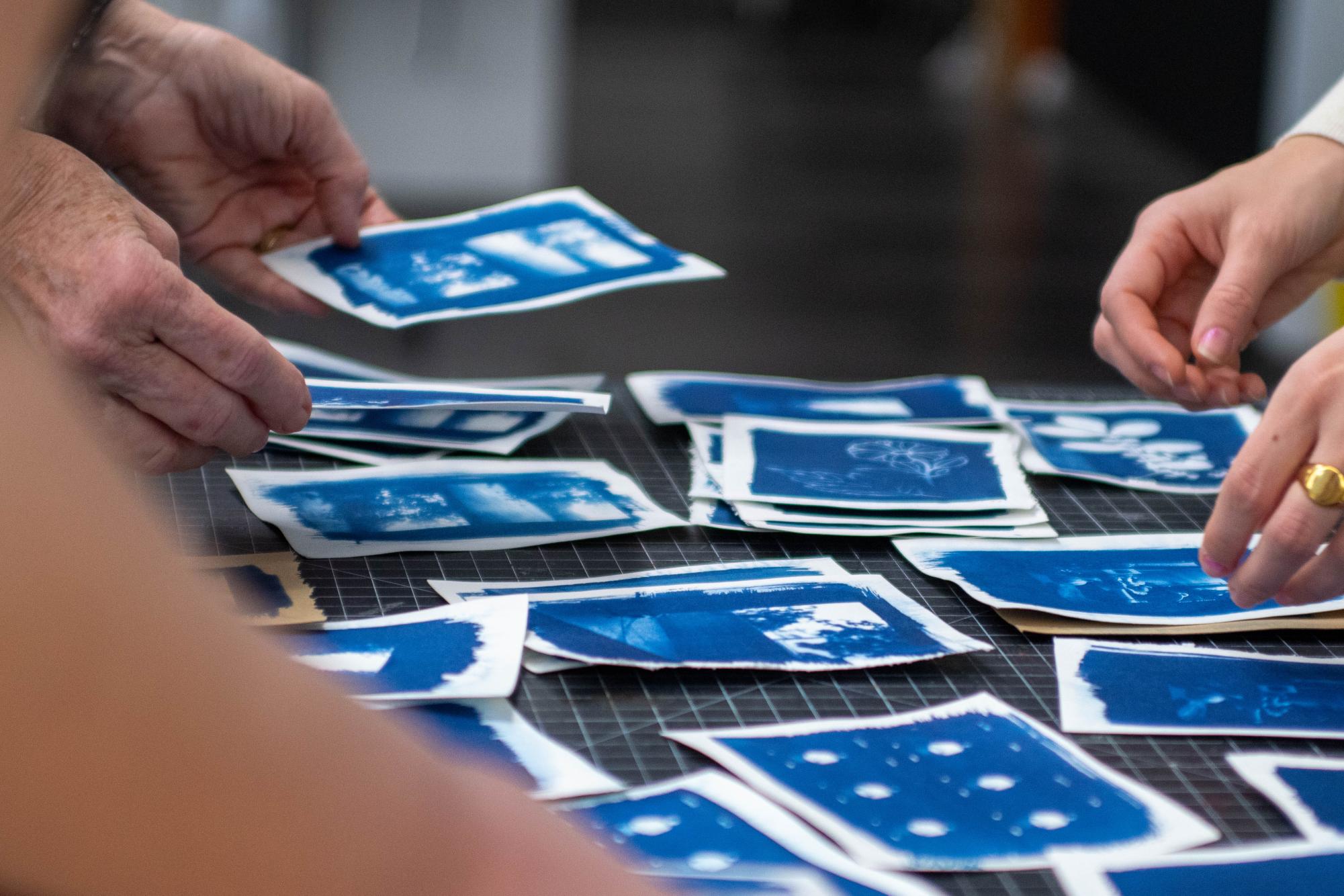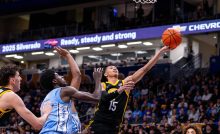The art of cyanotypes revamped with the Text & conText Lab


Students sort through cyanotypes at the Beyond Blue: Toning Cyanotypes workshop in Hillman Library on Wednesday, March 19.
Tables were lined with excited faces, art supplies and eye-catching bright blue papers during the Center for Creativity’s “Beyond Blue: Toning Cyanotypes” workshop. Hillman Library’s Text & conText Lab held the event on Wednesday, March 19, from 4 to 5:30 p.m., allowing Pitt affiliates to learn about cyanotypes and work hands-on with the popular and versatile art form.
A cyanotype is a photographic printing process invented by botanist Sir John Herschel in the mid-1800s. Its chemical process, which pairs a light-sensitive chemical solution with a light source, results in a signature Prussian blue color surrounding the outline created by its subject — this is how the term “blueprint” transpired. While its roots are in botanics and technical drawing, many artists have since used the technique as an entry-level form of photo processing. It is relatively simplistic and accessible since it does not require a dark room or even a camera.
Ariel Skovera, a C4C staff member, described the process as a chemical mixture working with a light source.
“The process is, there is a light-sensitive chemistry that’s coated onto a surface — whether that be paper, fabric, wood — and then you place objects or photo negatives on top of it. Once it is exposed, whatever that object sitting on the paper is blocking, the chemistry under that object will not get exposed,” Skovera said. “Then you take the paper or whatever object you have coated with the chemistry, you place it in water, and you kind of wash all that unexposed chemistry away. What happens is the burned, exposed chemistry turns into a beautiful Prussian blue.”
Skovera has worked at the C4C for about two and a half years, starting as a creative assistant. With a background in photography and filmmaking, she introduced cyanotype toning to the space, an event that reoccurs a couple of times per semester. Skovera and her co-workers rotate to maintain the C4C’s many spaces, including the Text & conText Lab, the Workshop and the Understory.
The event opened with a slideshow and then allowed participants to use watercolor paints, black coffee, green tea and black tea to tone pre-made cyanotypes. This alters the typical blue color, bestowing the artwork with new colors and highlighting its dimensions.
Each of these liquids will have a different effect on the blue cyanotype. For example, green tea will produce a shadowy, eggplant hue and potentially a blushing effect. Black tea will create a brown, strong hue, but most herbal teas will not be strong enough to stain a print. Coffee will create a cool tone, enhancing the blue color to have a gray effect. To successfully tone a cyanotype, Skovera recommends aging prints at least 24 hours, pre-wetting the surface and creating multiple copies of each print, for safety.
Noor El-Dehaibi, a Pitt employee, learned of the workshop via a university email listing. El-Dehaibi continued to describe her toned print as a spectrum of colors, varying in shade and intensity.
“I think it was in a PittWire, or like, one of those University communications that they send out,” El-Dehaibi said. “I think that this is a fun space to do a color gradient thing. Tried out some natural dyes, and over here, I have a warm color side, and then a cool color side.”
Similarly, Rachael Gavlik, a senior pharmacy major, was eager to register for the event before it had reached capacity. Gavlik began toning with the natural liquids before gravitating to brighter watercolors, creating an intricate mixture of the two methods.
“I saw an email from the Center of Creativity with a list of workshops. I know they fill up fast, so I immediately signed up,” Gavlik said. “I started with some teas and coffee and migrated to watercolors. I’m finding a mix of them both, because the colors are really pretty and a really nice contrast to the blue. But then there’s something very inviting about the brown.”
Hillman Library’s “Text & conText Lab” hosted the workshop. The space aims to combine an artist’s love for words with visuals, “Including graphic novels, illuminated manuscripts, and handwritten letters” with tools like a printing press. The C4C’s other spaces include the Cathedral of Learning’s “Understory” and the University Store’s “Workshop.” While the spaces are usually open to any interested Pitt-affiliated individual, they occasionally reserve the space for academic classes, department or organization bonding or special workshops like “Beyond Blue: Toning Cyanotypes.”
“All of our spaces are open to anyone that’s part of Pitt — anyone that has a Pitt ID, so undergrad, graduate, faculty, staff. And whatever’s open is free to use. Anything you want to try out, we’re here to help get you started,” Skovera said.
Recent Posts
Notes From an Average Girl // Notes on Book Banning
In this edition of Notes From an Average Girl, senior staff writer Madeline Milchman writes…
To Be Honest // Yup, it is that damn phone
In this edition of To Be Honest, staff writer Evin Verbrugge writes about her phone…
Meaning at the Movies | Portraying Toxic ‘Adolescence’
In this edition of Meaning at the Movies, staff writer Lauren Deaton explores the mini-series…
Opinion | Climate change requires radical, immediate action
Contributing editor Emma Hannan talks about the effects of climate change and the actions cities…
Jaland Lowe enters transfer portal, becomes fifth Panther to jump ship
On Tuesday morning, it was announced on X that Pitt sophomore guard Jaland Lowe was…
College Democrats and Republicans debate pressing political topics
Around 100 students gathered to watch Pitt’s College Democrats and College Republicans debate a variety…

